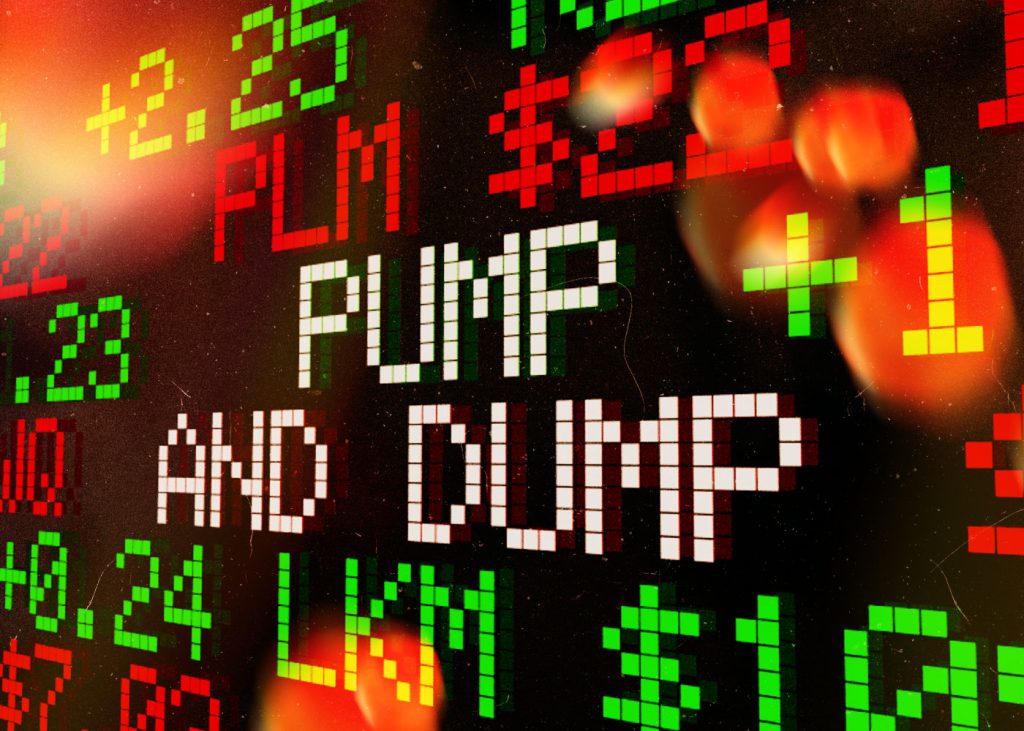A Pump-and-Dump is a market manipulation technique used to artificially increase the demand for a coin (or any other asset). Disreputable investors then take advantage of the value increase to sell their cryptocurrencies, making a large profit off the trapped investors. How can you prevent being a victim of a Pump-and-Dump, and how can you spot one?
A Pump-and-Dump is a fraudulent market manipulation tactic in which powerful investors purchase a significant volume of a low-priced and illiquid cryptocurrency. They then promote good stories about cryptocurrencies on social media and other platforms in order to entice other inexperienced investors to buy as well, hence creating a false demand for the currency.
What is a Classical Pump-and-Dump in the Stock Market?
In a Pump-and-Dump operation, fraudsters generally disseminate false or misleading information to generate a purchasing frenzy, “pumping” up the price of a stock and then “dumping” shares of the stock by unloading their own shares at the exorbitant value. When the fraudsters sell their shares and cease advertising the stock, the stock price drops, and investors lose money.
False or misleading information regarding a company’s stock price may circulate via investment research websites, social media, investment newsletters, online ads, email, Internet chat rooms, newspapers, direct mail, magazines, and radio. Because there is typically less publicly available information on microcap firms, they are highly susceptible to Pump-and-Dump tactics.
Cryptocurrency Pump-and-Dump Schemes are Frivolous
In these schemes, a false demand scheme causes the price of the cryptocurrency to rise, luring additional investors who feel they can profit quickly by investing in it. The perpetrators behind the Pump-and-Dump then use the price gain to sell their coins, generating a substantial profit.
Nevertheless, after these individuals have sold their cryptocurrencies, the price begins to plummet, frequently dramatically, causing large losses among investors who are stuck and ignorant that they are at the center of the process. This is a simple method of manipulating the market.
It should be emphasized that this behavior is not limited to the cryptocurrency market; it also has an impact on the stock market. Yet, because many cryptocurrencies have extremely little liquidity and the market is not yet fully regulated, unscrupulous persons may set up Pump-and-Dump operations relatively simply.
Furthermore, anyone may create a new cryptocurrency for only a few bucks. As a result, it is not unusual for cryptocurrencies to develop solely for the aim of doing a Pump-and-Dump. Cryptos of this sort are frequently referred to as shitcoins.

YYDS: An Example of a Crypto Pump-and-Dump which Occured Recently
Let’s take a look at a Pump-and-Dump pattern that occurred on the BNB Chain token, the YYDS. On March 14, 2023, at 2:30 p.m., a liquidity pool combining the YYDS and the WBNB is formed. This token soared higher and increased by more than 83,000% in just 10 hours and 30 minutes, rising from $0.10 to more than $187.
The token’s liquidity is then fairly decreased, ranging from 35,000 to 60,000 dollars, depending on the time. After this dramatic ascent, the YYDS token crashed, losing about 72% of its value in 1 hour and 15 minutes, plummeting from $187 to less than $53.
A fast search for a specific YYDS token on the web or on Twitter gives no results. As a result, it is conceivable that the YYDS token was published in a private group, such as those available on Telegram.
It is, therefore, highly likely that it is a Pump-and-Dump scheme, with those who began it selling their YYDS tokens on the backs of investors who are too misinformed about this practice, drawn in by greed that is simply too good to be true.
How to Avoid Pump-and-Dump Schemes?
You may avoid slipping into the Pump-and-Dump trap by taking a few precautions. Prior to actually investing in any cryptocurrency, it is critical to conduct sufficient research. Don’t depend just on online rumors and investment advice. For insight on the cryptocurrency in issue, consult reputable and verifiable sources like its whitepaper and its official website or an expert in this field.
Little-known, freshly produced, and illiquid cryptocurrencies may be more prone to being targeted by Pump-and-Dump techniques. This appears to be the case in the YYDS example above. Simply avoid investing in cryptocurrencies whose prices fluctuate dramatically over a short period of time. Don’t succumb to FOMO (Fear of Missing Out).
Investing offers that appear to be too good to be true are almost always investment traps. Beware of investments that promise large returns in a short period of time. Long-term investing techniques can assist you in avoiding Pump-and-Dump traps by allowing you to make informed investment decisions. Invest in cryptocurrencies that have a track record and underlines that you understand.
There are numerous courses and professional voices available to assist you in grasping the complicated world of cryptocurrencies if you are a newcomer. You may also join legitimate groups where information exchange is prioritized and where daily tips (airdrops, new protocols, new trends) are provided to community members in order to raise awareness for both profits and frauds.
